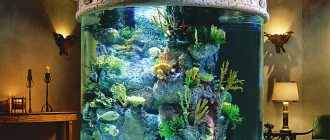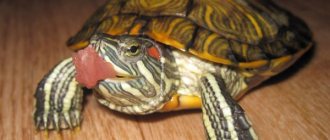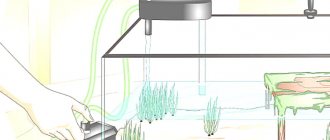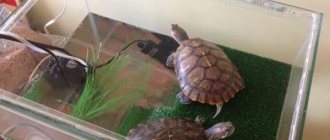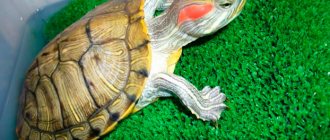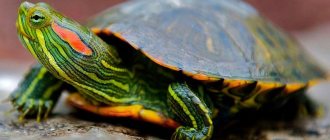If you have already purchased a glass aquarium, selected fish of certain species and plants, added decorative elements, but something is still missing to complete the picture. To add expressiveness and completeness to a small aquatic world, use an aquarium background. It is better to think in advance about the arrangement of the “water world” and select an aquarium background even before launching and populating the living creatures.
What is the background for?
An aquarium background is an attractive decorative element that can be purchased at any aquarium store.
It performs several important functions:
- The wall behind the aquarium, which “interrupts” the seascape, is hidden from view. When “diamonds” and “stripes” are visible through the water column, the reservoir looks unnatural.
- Hides electrical wires, sockets, parts of equipment that are located behind the aquarium.
- A correctly selected panorama creates a sense of perspective inside the water tank, visually expanding the space.
- Absorbs light glare, thanks to which the inhabitants of the reservoir feel in an environment close to natural conditions.
- A beautiful background makes the aquarium landscape rich and rich, without taking away space from the fish.
All these functions will work if the background is in harmony with the aquatic environment, and its execution is neat and durable. It is advisable to stick to a marine theme, which depicts aquatic plants, corals and fish. If the aquarium is oversaturated with plants and other decor, it makes sense to choose a monochromatic option.
What to do if the film lays unevenly, how to get rid of folds and bubbles?
In the absence of skills in working with film, wrinkles and bubbles appear. If you couldn’t do without them, don’t be upset: you have 3–6 hours to correct the situation. What can be done:
- Poke small bubbles with a needle and press the film at the puncture site to the glass.
- Peel off the film completely and repeat the operation. It is necessary to peel off gradually, in small sections, while simultaneously stretching and leveling the film sheet. For better results, you can heat the film with a hairdryer or fan.
- For novice designers, it is better to take a thick film for their first experiments and use a soap solution to stick it on.
Advantages of background film
There are several background options that can be mounted inside or outside the aquarium. Sometimes these two types are combined with each other. The background that is installed inside has some limitations. It should be chemically neutral to the aquatic environment, its reliefs should not take up the lion's share of space from the fish.
The most affordable way for beginner aquarists is a background film. It belongs to the external variety of aquarium backgrounds and does not come into contact with water. Its advantages are as follows:
- Low price, which does not in any way affect the stunning effect of this decor option.
- A huge selection of pictures that can be found in the store.
- Installation is quick and easy, without assistants, without the use of special tools.
- The film on the back wall saves space in a small aquarium, which cannot be cluttered with decor and plants.
- This interior solution is easy to change from time to time. In this way, the water landscape will also change.
- The film material glued on the reverse side does not come into contact with the aquatic environment. Does not harm fish and is a durable material.
It is easier to glue a film background onto a small aquarium. Even if there are a few unsmoothed bubbles left, they will not be noticeable. When you decide to use this type of decor for large containers, you need to be especially careful. Otherwise, all efforts to arrange the internal space of the home for aquatic inhabitants can be reduced to zero.
The film can be sold in three versions:
- With an adhesive solution applied on the reverse side under a protective layer. At first glance, it seems that gluing self-adhesive film is the easiest way. However, not everyone can do this smoothly and accurately the first time.
- Regular film, with a smooth, clean surface on both sides. To attach it to the back wall of a glass tank, you must use adhesive solutions or attach it with tape.
- A film with a paper base on the reverse side. Experienced aquarists advise to immediately separate the paper, otherwise it will not be possible to align the background with the glass surface.
Most often you have to deal with ordinary film, which is glued using means that ensure adhesion to glass.
Direct gluing
Direct gluing can be used if design changes are not expected. Getting rid of the pasted film is problematic and will require a lot of time, so you must first evaluate whether it is worth making a permanent design.
It is also allowed to paste the background from inside the aquarium. The film is made from materials that are safe for its inhabitants and does not affect the quality of water. The only limitation for gluing the background internally is the use of methylene blue in the aquarium, which will color it.
The background film is glued to a surface that has been previously cleaned and wiped dry. Gluing is done in the same way as when using a base board. The only difference is that the excess decor is cut off and not wrapped around the base. It is convenient to trim off the remaining background with a cutter. Additionally, after smoothing the film with a soft cloth, the aquarium is left without water for 2 days so that the glue adheres tightly to the glass. When filling a reservoir, you should not pour water over the wall with the background.
If the film needs to be removed, it will be very difficult to do so, as it leaves traces of glue on the glass. It is impossible to wipe them off with a sponge. To remove glue residue, use tape, which is glued to the stain and peeled off after 2 minutes. The tape will take any remaining glue with it. The procedure is troublesome and lengthy. This is taken into account when gluing the background to the glass.
How to glue a background to an aquarium with glycerin
There are several ways to attach film to the back wall at home. Experience shows that ordinary medical glycerin copes best with the task. It is absolutely colorless and non-toxic. Unlike soap solution, it does not leave annoying streaks.
Required material and tools
To glue the film to the aquarium, you need to prepare the following material and tools:
- a bottle of glycerin;
- background film;
- 5-10 napkins;
- stationery knife;
- silicone spatula.
On a note! The spatula successfully replaces an out-of-use plastic card. If you have a hard piece of cardboard at home, you can use that.
Stages of work
Before gluing the background to the back wall of the aquarium, you need to free it from aquatic inhabitants, drain the water, wash, clean and dry. The size of the film must be adjusted to the dimensions of the rear window minus 3-5 mm. If the edges of the film protrude, this will affect not only the aesthetics, the film will quickly peel off. The excess must be cut off immediately, before the film is glued. It will not be possible to do this exactly on the spot.
Next we proceed as follows:
- Place the aquarium on a flat surface (table, floor) with the back wall facing up. You must make sure that the surface is clean, free of dust and lint. It's better to play it safe and clean it with glass cleaner.
- Apply glycerin drops evenly onto the surface of the glass. 50 ml of product is enough to glue the wall of a 50 liter aquarium. Brushes should not be used as they may leave lint.
- Carefully glue the film on top, gently pressing it to the surface.
- Now you need to slowly scrape the glycerin to the center of the film using a silicone spatula.
- After the glycerin is collected in one place, we begin to distribute it evenly over the surface. It is necessary to move the spatula in all directions, from the center to the edges of the aquarium.
- Glycerin protruding from the edge should be immediately removed with a napkin. To prevent the spatula from getting dirty with glycerin, you can wrap it in a napkin.
- After the work is completed, you need to carefully inspect the surface again for the absence of folds and bubbles.
You can paste the film within 15-20 minutes. Unlike water or soap solution, glycerin hardly forms bubbles. Therefore, all that is required from the aquarist is to straighten all the folds and expel excess glycerin to the edges. The glycerin film holds very tightly. If necessary, it can be removed and replaced with another one.
Options on sale
You can, of course, not make the back wall of the aquarium with your own hands, but buy it ready-made. The background can be monochromatic or with different images, for example, landscapes, a view of the seabed, algae and other pictures. There is a three-dimensional background for the aquarium that looks very effective. Also on sale, photographic backgrounds are divided into film and relief. The advantages of the first are:
- low cost;
- diversity;
- easy replacement;
- ease of installation.
Such a back wall can be installed using glycerin, but this installation method is very difficult. Much simpler, but no worse, you can use a soap solution for fastening. First you need to measure the film, it should be slightly smaller than the surface of the glass. You need to wipe the wall of the aquarium, spray a soap solution over it, separate the film and squeeze out the water. The best option is to use special glue.
You can make the background voluminous
There are also similar backgrounds, but with three-dimensional images. Most often, as an addition to such back walls, various groups, mountains, caves are purchased, which should be installed inside the container.
A sheet background based on PVC film is considered quite convenient and beautiful. The pictures are just as varied as in the case of three-dimensional images. Basically, such a background is attached to the back wall using special tape. But again, experienced aquarists recommend using special glue.
There is also a so-called relief background, the manufacturers of which promise non-toxic materials. There are different options for attaching such a back wall to the surface of the aquarium:
- Using silicone glue, which is included in the kit.
- By pressing a layer of soil or stones onto the back surface of the aquarium.
It is worth noting that such design of your home water corner is very expensive, and it often looks too academic. As a rule, the background has a standard width and length. If for some reason the container does not meet these parameters, for example, if it was made independently at home, then choosing a background for it will not be easy. This moment can be attributed to the negative aspects of the relief background.
The background can be glued with glue
Secrets of getting the job done
First of all, pay attention to the dust. Because of this, bubbles can form on the film, which can be noticeable and spoil the entire appearance of the aquarium. A big disadvantage will be the shadow from this dust when the backlight is turned on. Therefore, it is necessary to take care of the cleanliness of the back wall. Before gluing the film, you need to thoroughly spray water around the work area so that dust does not fly around you.
A soap solution and a spray bottle will be an assistant in cleaning glass. Spray the soap solution onto the glass and wash the surface thoroughly. Some aquarists manage to glue the film onto a soap solution, but it is almost impossible to achieve a thorough fit and no streaks.
Thus, sticking the film on the aquarium will not be difficult. It is easy to manipulate, so you can glue one today and another tomorrow, changing the interior of the aquarium at your discretion.
I do it simply (page 4)
I glue the film with tape on the outside of the aqua. if you are afraid that it will start to “move away” in the center, then I press it down with cardboard and stick it with tape: wall-film-cardboard
Oh yes! and one more thing: be sure to glue the entire length of the connection between the film and glass on top (and not grab it in 2-3 places) so that water does not flow under the film
Modified 11/13/08 by Brenda
Glue onto hair styling gel. Overclock with a credit card. Tested from my own experience.
Please tell me how to glue the background inside the aquarium.
sweet water and no bubbles, no need for tape either
Not all backgrounds can be glued to glycerin and Vaseline. Some backgrounds (thin, one-sided) from glycerin and petroleum jelly (and other petroleum products) dissolve, warp, and become discolored.
This is when glycerin, especially used in medicine, began to be made from oil.
Easily formed by the hydrolysis of natural fats and oils (triglycerides), it was first obtained by Karl Scheele in 1779 during the saponification of fats. In industry, glycerin is obtained by saponification of fats, mainly as a by-product in the soap industry, and also synthetically.
As an option, glue it to a soap solution applied from a spray bottle, similar to tinting car windows.
Interesting. Some people fall for beer and sugar. but didn’t you think that over time this could be good food for all sorts of insects that guests bring to you or fall through the window window. or something else. I mean, you can eventually get a breeding ground for wickedness
Not long ago I glued a new background onto the shampoo, everything turned out great. There were no bubbles, I smoothed it out with a device for washing windows, on one side there was a sponge and on the other there was rubber for wiping. I applied shampoo with water with a sponge. I wetted both the film and the glass, and removed the excess with rubber so that the rubber glides better by wetting the film on the back side of the film. Good luck to everyone!
I've had it like this for a couple of years, I like it, the aqua looks deeper, the only downside is that dust regularly accumulates on the mirror, you have to take it out, wash it, and put it back.
my aquarium is a month old, so for the first week all I did was re-glue the background several times - both on water and on sweet water and on very sweet water, and pierced the bubbles with a needle. If not immediately, then the next morning bubbles appeared. I found tetracycline in glycerin in the refrigerator. In any pharmacy it costs 15-20 rubles. Holds up great.
I haven’t read everything, but if you need a plain background, then the best option is oracale film, sold in printing stores, it is glued to the water from the outside, then when the water dries, all the stains go away and the look is generally super, better than any glycerins, 100% tested
here, it’s bad viddo, but mine is sealed with blue film
Own on Aqa.ru, Advisor
It's funny of course.
. but I was in an aquarium with telescopes (for a long time), I glued the background to the aspic broth, it held up perfectly for a year, but then something like a black fungus began to appear between the glass and the background. Now I also have to glue the background onto a new aqua, but this time I will buy glycerin.
I took a film that was used for pasting furniture or something else, wetted the glass and sculpted it, smoothed it. Of course, I may not have looked too closely, but no streaks from the glue are particularly noticeable, you just need to let it settle. In the caption there is a 2nd photo, a shrimp tank, this is the background there.
Modified 13.5.09 by Degett
Well, finally, at least one answered with dignity. Stick it on beer like you put tint film on car windows. Naturally on the outer wall of the aquarium.
Kalyasik's message
I haven’t read everything, but if you need a plain background, then the best option is oracale film, sold in printing stores, it is glued to the water from the outside, then when the water dries, all the stains go away and the look is generally super, better than any glycerins, 100% tested
here, it’s bad viddo, but mine is sealed with blue film
funt This is strong for intimate lubricant! I spent half the evening reading this topic. In my opinion, the people are divided into two camps, and completely do not want to understand each other. Namely: some glue it to tape (any kind, double-sided, construction tape, transparent), apply a background and press it with something, others glue it to liquids (sweet water, beer, liquid soap, Vaseline, glycerin). These are two completely different results. In the first case, the background is dark, in the second it is more natural and bright. Of course, whoever likes it more. But I noticed a difference. My background was taped with transparent tape around the edges (not very carefully), but when I lifted the lid, water got under it, it stuck in places, and the difference is obvious. Hence my observations on this topic, how best to glue it. IMHO: I’ll go now and glue the background onto dishwashing liquid. And if it ever comes off, I’ll buy glycerin and stick it on it.
Source
External
Film
The external decor option is made of film, quite cheap and easy to install.
It can be purchased at any specialty store and can be easily replaced if necessary. There are aquaphones made from thicker film with three-dimensional images. They are more original and varied. Such decorations can be glued both on the outer and inner walls.
Background film for aquarium
Drawn
One of the easiest ways to decorate a background is to paint it yourself.
For painting, you can use pre-prepared stencils and indelible paint.
If it is not possible to paint the glass yourself, you can simply paint it evenly with paint from an aerosol can.
Painted background
Is glycerin harmful to silicone? (page 5)
One person has already asked here and I will repeat the question, since after gluing the background, my glycerin flowed into the plastic mold in which the bottom of the aquarium was placed. What happens to glycerin?
The same problem, I glued the background to glycerin, it certainly looks beautiful, but everything is stained and the background walks across the surface of the glass when touched, I couldn’t stick anything with tape, since nothing sticks to glass stained with glycerin. Today I’ll tear everything off!
I’ve already ordered a piece of self-adhesive (oracle, in my opinion) in black from my friends, and I’ll glue it on cheaply, practically and beautifully.
And I simply attached the background with tape)) True, this was on a small 20-liter aquarium.
draped in black cloth
I glued the background film using Nivea liquid hair wax for volume)) it holds up great...dries quickly. air bubbles were removed with a plastic shoe store discount card
and I glue with liquid soap. bubbles are easily squeezed out. The background has been in place for six months now)))))
Well, it seems clear who glues HOW, but who glues WHAT? Tell me what background looks most advantageous in an aquarium with live plants? I was already thinking about simple blue. then I wanted a photo where large stones were painted, someone actually glued them in black.
I looked at it, it’s really beautiful! The driftwood is gorgeous!
Tell me, friends, has anyone tried to “fill” the rear glass of an aquarium with black paint from the outside? For example, just paint over it with a can of car paint, what happens? Thank you.
I also think about black paint, if the aqua is not lined with a plastic frame on top, the background swells from the pressed devices
Hello. I glued the background to a special gel, which was sold along with the background. This gel is very liquid. Pour it onto the glass, distribute it over the entire area of the rear window using a plastic card. Then apply the background and smooth it with a plastic card, pushing out the bubbles. This method is used to tint car windows. With a little work you have a great background, no bubbles. Let me remind you that you need to smooth it with a plastic card, neither with your hands nor with a cloth.
The background was glued poorly (( I bought JBL Fixol, first they glued it on it, it turned out very well, but there were bubbles left, in general, in the end this glue was transferred, the plastic spatula that came with the kit was probably erased by 1 cm
, the bubbles remain. It was decided to clean everything and stick it on the shampoo, again the same thing, clumsily. The last option is to use a soap solution. Everything became perfect (deep black color), but a day later it was PPC. All the abrasions (from the spatula) on the films became visible, some other stains, a lot of bubbles, etc. It looks creepy.
In general, I want to drain the water, unfold the aqua and paint the back wall with water-based aerosol (spray) paint. Again, black, but I don’t know which one to take, matte or glossy (metallic), what do you think? Does anyone have any experience with painting? The question has already been asked in the posts above, but there are no answers.
ps. I just don’t want to stretch the film onto tape, because I want a deep black effect. (do you need matte or glossy paint?)
Source
